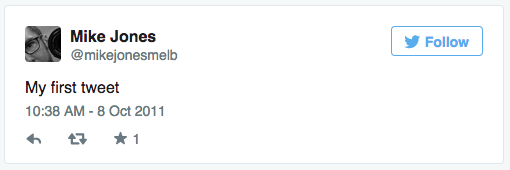As soon as I publish this post I’m going to head over to Twitter and send out the link with my 20,000th tweet. Here was my first.
Accurate, but otherwise not an auspicious start. Those who follow me will also note I’m still using the same profile picture. I will leave it up to you to decide whether this qualifies as ‘effective branding’ or simply laziness.
Over the past few years Twitter has become a significant part of my life. There is a tendency sometimes to think of social media as time wasting, as something you do instead of life; and many (me included) use the acronym IRL (in real life) when talking about meeting people offline. So as I pass the 20,000 milestone it’s a good time to write a little about my own time in the wonderful, expansive, and sometimes infuriating Twitterverse.
Like many, I started slowly. With almost no followers, and following a short list of large organisations, archives, libraries and a few friends and colleagues, it was difficult to get a timeline flowing, let alone any steady interactions. I dipped in and out, each time shrugging and moving on.
Then, in March 2012, I attended the inaugural conference of the Australasian Association for Digital Humanities (AADH) in Canberra. There were many people there I knew, and lots of tweeters, so I threw myself into the hashtag and it was a revelation. I expanded the list of people I was following (and my own list of followers gradually started to grow), held online conversations during and between sessions with people I had never met, and watched as sessions were enhanced or critiqued with a flurry of references, links and interactions on the Twitter backchannel.
Following the AADH conference, I started to visit Twitter nearly every day. Aside from a few friends, my main focus was professional, and my Following/Followers lists remain skewed toward archives, libraries, museums and galleries (GLAM), as well as historians, academics and researchers of various sorts. With very few exceptions I don’t follow bands, musicians, writers, actors, or other ‘famous people’, mostly because they clutter up my timeline; and I get most of what I need from the people I follow already.
I continue to use Twitter professionally, to find out about developments in the GLAM sector, interesting research, blog posts and articles, and to build professional networks. There are colleagues I have met as a result, and colleagues I am keen to meet when I have the opportunity. I have talked about project ideas, sought advice (and given it), found help, and become involved in paid work, all as a result of online interactions. Plus I still tweet frequently at conferences, both as a way of engaging with others and to capture notes and links I can refer to later; and I regularly follow the hashtags of conferences I am unable to attend.
Perhaps most significantly, I gradually revealed more of myself. Now I don’t only tweet about work, archives and study – mine is a hybrid professional/personal account, including tweets about music, politics, social issues, travel, and whatever else is happening in my life, punctuated by the occasional multi-tweet rant. I have built an online network of people I socialise with, including a growing number I have subsequently met offline, and there are a number of people I am yet to meet face-to-face who I interact with more frequently than I do with my family and nearly all my ‘non-Twitter’ friends.
I have talked, shared, joked, laughed, and cried, just as I have been angered, maddened and saddened by the way some people act, on Twitter and off. All of which sounds like RL to me.


July 22, 2015 at 1:59 pm
I found this post because I was searching your Twitter stream for something useful you had tweeted this morning (the one about the new Women’s Heritage Centre). 20,000! That’s a lot of value tweeting you have done Mike! I think one of the lovely things about Twitter is meeting like minds online, but the bonus is when you subsequently met them off-line. It was great to finally meet you at dh2015.
July 23, 2015 at 11:19 am
Great to finally meet you too Yvonne! And thanks for all your tweeting and blogging.